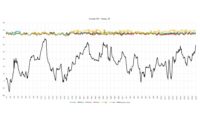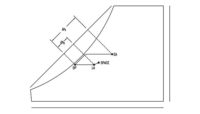In the summer, conventional air-conditioning systems in buildings are challenged to meet peak humidity loads. Over time, buildings have reduced their heat (sensible) load, but have done less to reduce their moisture (latent) load. As a result, this moisture load can become too large for conventional air-conditioning systems to handle. Facilities then struggle with condensation dripping from diffusers, drain pans overflowing, and evaporator coils freezing. Excessive dampness also increases the number of microorganisms, allergens, mold, and bacteria that grow, possibly causing health concerns and damaging building materials.
In applications with a significant moisture load (i.e., where more than 15% of the air conditioner’s total load is moisture removal as opposed to cooling), these issues become acute and should be addressed with dedicated dehumidification equipment. Such equipment has been available for decades but has to not been widely used as the upfront cost, maintenance requirements, and energy use historically have been somewhat larger than conventional air conditioning systems.
Conventional air conditioner design has been essentially the same since its invention in the early 1900s. Warm air is passed over a cold, metal coil that extracts (sensible) heat from the air. If the coil remains below the dew point of the air, it will also extract moisture (latent heat) and dehumidify the air. Over the years, these systems have become progressively more efficient at cooling that coil, thus reducing the energy needed to remove this sensible and latent heat from a building. However, they remain limited in dehumidification capacity because the air flow specification (typically 400 cfm/ton) and coil design (fin configuration, temperature, etc.) are focused on meeting that sensible heat load. Therefore, a standard coil struggles to remove more than 15-25% of its heat as latent heat.
For applications where the Sensible Heat Ratio (SHR) is close to 0.85 or higher (i.e. 85% or more of the load is cooling the air), en-gineers typically specify conventional DX or water cooled coil systems to handle both the thermal and the humidity load. In such cases, conventional systems are relatively inexpensive and can provide sufficient dehumidification on peak load days for such applications. Even these units, however, may not dehumidify sufficiently on non-peak days as the SHR drops below 0.85. The reason is simple: these units usually have only a temperature-controlled set point (i.e., thermostat). Thus, once the room air is sufficiently cooled, the unit will switch off whether it has removed any humidity from the air or not. This can cause the building to be uncomfortably humid, outside the ASHRAE comfort zone, 25% or more of the time.
DIFFERENT APPROACHES FOR ADEQUATE HUMIDITY CONTROL
ASHRAE recommends using a separate, specialized piece of equipment to solve ventilation challenges.
Here is what ASHRAE has to say from the 2011 ASHRAE Handbook – HVAC Applications, page 7.7 under “Dedicated Outdoor Air Systems.”
“Dedicated Outdoor Air Systems (DOAS). Although most centralized and decentralized systems are very effective at handling the space sensible cooling and heating loads, they are less effective (or ineffective) at handling ventilation air and the latent loads. As a result, a dedicated outdoor air system (DOAS) should be used. DOAS units bring 100% outdoor air to at least space conditions, which allow individual space units to handle only the space load. It is preferable, however, to introduce the outdoor air at a low humidity ratio than the desired space humidity ratio, to allow the zone HVAC unit to handle only the space sensible cooling load.”
Applications with strict humidity requirements or an SHR consistently lower than 0.85 typically require dedicated equipment opti-mized for the latent rather than the sensible load. Three technologies are commercially available to handle this moisture load: mechanically-based Dedicated Outdoor Air Systems (DOAS), solid desiccant wheels, and more recently, liquid desiccant systems.
Mechanical DOAS systems are a widespread solution for comfort cooling applications. By lowering the airflow per unit capacity (as low as 125 cfm/ton) and using specially designed evaporator coils, potentially six-rows deep, they can achieve significantly more moisture removal, providing coil SHR’s as low as 0.5. But this performance comes at a cost. They have a higher upfront cost: ton-for-ton they will cost typically two to three-times as much as conventional equipment per cfm. They also have higher operating costs: unit EER can range from 6-10 while conventional systems will run at 11 or higher. Compounding this decreased efficiency; is the air must be significantly overcooled to reach the desired dewpoint. The air must be reheated using either hot gas from the condenser, steam, direct gas heat, or electric resistance strips downstream (e.g., in a VAV system). Also, this approach suffers from what is known as latent degradation at part-load capacities, making it even less effective on the cooler but still humid days when it is needed most. Finally, these devices do have a significant limitation. They will provide air at a dew point no lower than ~40°F. If these costs and drawbacks prove unacceptable, then engineers are forced to look for alternatives.
Solid desiccant wheels often prove to be the first alternative investigated. These devices can overcome the dehumidification limitation of mechanical systems and provide air at sub-zero dew points. But this increased performance comes at an even higher cost. These systems will typically double the cost of a mechanical DOAS system in a cfm-by-cfm comparison. They typically use at least as much energy as a mechanical DOAS system and require significant amounts (as much as 4,000 Btu/lb of moisture removal) of high-quality heat (in excess of 250°F) to continuously remove the collected moisture from the wheel and exhaust it into the outdoor space. Intrinsically, this dehumidification process heats the air, thereby requiring pre- and post-cooling. Finally, these systems tend to be higher in maintenance cost, as the high temperature heat limits the usable lifetime of the wheel to 3 to 6 years.
LIQUID DESICCANT THERMODYNAMIC SHORTCUT
Liquid desiccant (LDAC) systems prove a newer but increasingly attractive alternative. Liquid desiccant systems cool a salt-water solution to depress the air’s dew point inside the unit. This allows the unit to simultaneously remove 70% of the humidity and drop the air temperature ~10-20°F; this will provide outlet conditions typically around 60-70°F and 20-40°F dew point (though outlets as low as -20°F and dew points as low as -40°F are possible in custom designed systems).
By cooling and dehumidifying air to the “right” conditions in a single process, LDAC systems eliminate the need for post-cooling or re-heating the air, making it an intrinsically more efficient process.
There are also functional benefits to LDAC dehumidification. Liquid desiccants, such as lithium chloride, are biocidal: they kill microorganisms they contact while remaining as safe for humans to handle as table salt. Therefore, LDAC manufacturers can configure systems to remove over 90% of airborne bacteria, microorganisms, and mold while scrubbing out particles with filtration exceeding a MERV 7 — all without the need for disposable filters. The technology also removes moisture from the building as vapor rather than condensate, thereby eliminating the need for drip pans or drain lines and the algae, bacteria, and system maintenance associated with them. In fact, a building using LDAC for all its dehumidification needs will run all its AHU coils dry, potentially eliminating this noisome maintenance requirement.
Finally, because LDAC desiccants regenerate at a lower temperature, around 150-165°F, liquid desiccant systems can be powered by renewable energy sources such as waste heat or solar thermal heat. And, the upfront cost for the new technology is comparable or even less than conventional systems — a top-of-mind issue for most HVAC professionals.
For decades, liquid desiccant has been a small player in the HVAC market, but with more focus on energy conservation and im-proved air quality, interest has rapidly increased. In the last few years companies such as Advantix Systems, Kathabar, and 7AC Technologies are offering these products. As such, the number and variety of applications using liquid desiccants is growing rapidly.
MANY BUILDINGS COULD BENEFIT FROM LDAC
Applications benefiting from LDAC fall into three categories: those that require low humidity, require high ventilation (especially in humid climates), or present a high internal moisture load.
Spaces requiring cool, comfortable conditions and low dew points (below 50°F) or low relative humidity (30-50%) benefit from liquid desiccant systems. Supermarkets, operating rooms, some commercial or industrial processes, and ice rinks are prime candidates for improved performance using this approach.
Health care facilities, schools, and hotels all have high occupant density and correspondingly high ventilation requirements. Laboratories require ventilation to eliminate toxic chemicals. These buildings especially in humid climates, can greatly profit from LDAC. ASHRAE best practice design standards call for separate equipment to treat ventilation and/or latent loads. By efficiently pre-treating the outside air, liquid desiccant systems eliminate the moisture load on conventional equipment, reducing the tonnage of these systems and gaining significant energy savings.
Finally, spaces with a high internal humidity load such as indoor pools, health clubs, and food processing facilities have high moisture removal requirements that cannot be easily and efficiently achieved with conventional equipment.
Table 1 provides a summary of the most applicable environments for liquid desiccant technology. The subsequent two case studies demonstrate the benefits of LDAC in practice.
A GROCERY STORE REDUCES SPOILAGE AND LOWERS ENERGY USE
The Bel-Garden Bi-Rite, a 15,000-sq-ft, family-owned supermarket in Baltimore, struggled to maintain comfortable indoor conditions and proper refrigerated case operation during the hot summer months (ASHRAE 0.4% design conditions: 94°F dry bulb, 75°F wet bulb). The previous HVAC system was a conventional rooftop sized to 20 tons. The store’s HVAC and refrigeration energy consumption, combined with rising energy costs, were driving up utility bills each year as well. Equipment shutdowns in the store were common and customers were spending less time in the store.
Sandy Vary, the owner of Bel-Garden, installed an Advantix Systems LDAC unit in summer 2012; its impact was felt immediately. The ambient air temperature was set to 77-78°F, reducing the load on the conventional system, while the LDAC unit maintained a 48°F dew point, even on the most humid days. This provided a cool, comfortable shopping experience for customers. Produce, frozen foods, and meat products are faring much better in these conditions. Previously, packages of frozen food vegetable in the cases would become “mushy” during stocking, and the defrost systems for the frozen food cases had to cycle three times daily. Packages of frozen vegetables in the cases would become “mushy” during stocking. After installing the LDAC equipment, these foods remained dry and frozen during stocking; the frozen food cases now defrost only once daily.
Even with these improved conditions, Vary achieved a 37% reduction in HVAC energy consumption. Additionally, she is saving 3% on her annual utility bill by reducing the number of defrost cycles, and another 3% by operating the store at warmer (but dryer and more comfortable) indoor conditions. When all of the savings calculations are added together, Vary has captured an annual energy savings of more than $35,000.
A PASTA CHEF IMPROVES HIS PROCESS AND PRODUCTS
Fiori Bruna Pasta, a 23,000-sq-ft pasta plant in Miami, has learned over time that dry conditions make pasta making easier. It is critical to keep relative humidity below 50% RH (75°F) to preserve the correct flour consistency, prevent clumping in the processing machines, and improve product quality. In the summer months (ASHRAE 0.4% design conditions: 92°F dry bulb, 78°F wet bulb) this is particularly difficult: proper sanitation requires a high ventilation rate (1,200 cfm outside air) and the inevitable infiltration and permeation of moisture into the factory make maintaining this humidity level difficult for conventional equipment.
Owner Jose Yamin installed a LDAC unit to pretreat the outside air to a humidity level below that needed in the space. This unit could then handle the internal humidity load and enable the facility to maintain the required conditions. This approach removed all need for the conventional system to dehumidify. As a result, he reduced his conventional cooling capacity from 40 to 25 tons and reduced his HVAC energy use by 15%. Health care facilities, schools, and hotels all have high occupant density and correspondingly high ventilation requirements; laboratories require ventilation to eliminate toxic chemicals.
CONCLUSION
Because they use less energy, and upfront costs are comparable to or lower than conventional units, LDAC systems offer engineers and owners a better choice for today’s buildings. Companies like Hilton Hotels, Proctor & Gamble, Duty Free America, and Tyson Foods have replaced their old HVAC units with LDAC systems, and all agree that liquid desiccant is the most innovative HVAC product to enter the market in decades. Now, engineers have a tool for providing an energy efficient HVAC solution for known building challenges without having to spend lots of money.
Farese is vice president of engineering for Advantix Systems. He is an author of the McKinsey report “Unlocking Efficiency in the U.S. Economy,” and previously worked at the National Renewable Energy Laboratory. As a supporter of energy efficiency, he developed a tool to prioritize energy efficiency investments with findings published by the journal Nature and in an NREL technical report.





